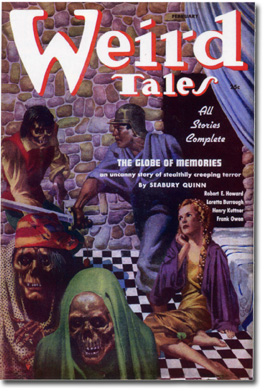Uncollected Letter in a Locke-box?
Tuesday, January 30, 2007
posted by Steve Tompkins
 Print This Post
Print This Post

[redacted]’s recent post offering a breakdown of the recipients of all those Collected Letters sent me back to Dennis McHaney’s Howard in the Eyrie — The Conan Years: Part Four, Conclusion, a chapbook from December 2002 (The contents of which were amalgamated into Robert E. Howard: World’s Greatest Pulpster, which I’ve been lamentably late in getting around to ordering) On page 14 of the chapbook (page 99 of Pulpster), which deals with the Eyrie section of the February 1937 Weird Tales, Dennis quotes a letter from one Robert Locke, of Kansas City:
It is seldom that one writer will become enthralled by a fellow scribe’s creation. Yet Conan, the character created by Robert E. Howard, so captured my imagination that shortly before his untimely death, I wrote a letter to him expressing my admiration. The letter which Mr. Howard wrote me is one of my most prized possessions. In it he stated his appreciation for my interest and promised that he would write many more stories, carrying Conan through the mythical countries of Khitai, Khosala, Brythunia, Corinthia, etc. . .
This intrigues me for several reasons. That first generation of Howard fans was the only one that enjoyed what none of us ever have, a window of opportunity for give-and-take with Robert E. Howard while he was alive and writing. I can but echo Rob’s earlier thoughts on this issue–if even a dozen or two dozen handcrafted REH responses to fanmail moldered away in attics and cellars or were mulched in the Forties, Fifties, and subsequent decades, that’s an intolerable loss. Locke describes the one he received as a prized possession; could his heirs, and their heirs, be located by researching Kansas City public records? At this late date, any such effort would be staring down a barrel of diminishing returns, but still…
Khitai, Khosala (surely Kosala, the country of origin for Baal-pteor of “The Man-Eaters of Zamboula” and the founders of Xuchotl in “Red Nails”) Brythunia, and Corinthia are all places that we never get to visit in the Conan stories we have; they are kingdoms of a more shadowy sort that would have triggered fannish curiousity then as now. Obviously, Howard’s “promise” to Locke was not a promissory note; he might well have been telling a fan who’d taken the trouble to write him what he thought that fan would like to hear. Locke’s “shortly before his untimely death” wording suggests that he wrote to Howard in early 1936 or perhaps late 1935, so his brief correspondence with REH was contemporaneous with P. Schuyler Miller’s. As we know Miller, who outdid Locke by working out a Conan chronology and even a map of the series’ worldscape, earned a more information-rich response in Howard’s March 10, 1936 letter:
He traveled widely, not only before his kingship, but after he was king. He traveled to Khitai and Hyrkania, and to the even less known regions north of the latter and south of the former. He even visited a nameless continent in the western hemisphere, and roamed among the islands adjacent to it. How much of this wandering will get into print, I can not foretell with any accuracy.
And yet the contents of the replies to both Locke and Miller seem to me to be evidence (of a sort) that although financial exigencies might have been forcing REH to walk away from Conan, Conan had not yet walked away from REH. In other words, Howard hadn’t lost touch with the character, in the way that we’re now accustomed to think of him as having lost touch with, say, Bran after “Worms of the Earth” or Kull after “By This Axe I Rule!” (Did the choices made by both of those kings in the stories just mentioned “damn” them in their creator’s mind? See Patrice Louinet’s thoughts about the post-putsch Kull in The Fantastic Worlds of Robert E. Howard or Kull: Exile of Atlantis) We’re way off in the wild blue yonder of speculation here, but there’s nothing speculative about the power of the last full Conan story we have, 1935’s “Red Nails,” which to me is not a summing-up or leavetaking and betrays no signs of being one last lava-flow from an about-to-be-extinct volcano. Howard’s “how much of this wandering will get into print, I can not foretell with any accuracy” caveat to Miller is quite different from his emphatic rejection, in a letter to HPL, of even trying to write another Kull story; the obstacle is not the distance that has opened up between creator and creation, but a “meal ticket” that had become anything but thanks to Weird Tales. The revelation, in the letter to Miller, of the Cimmerian’s landfall in the New World (Conan of Aztlan? Conan the Toltecian?) might be another clue; in the introduction to 2005’s The Black Stranger and Other American Tales I tried to hint that the teaser for a western hemisphere adventure might have shown intent, if Farnsworth Wright came across with more of the owed simoleons, to employ Conan as a human bridge, in keeping with Howard’s known M.O. when a new phase or persona was in the offing, between an existing-and-quite-viable series and Howard’s increasing predilection for Southwestern, Mesoamerican-adjacent settings (i.e. “The Thunder-Rider” and “Nekht Semerkeht,” both from the spring of 1936)
When we know about something, like the letter to Locke, but time and chance deny us access, the sensation is the aficionado’s version of the amputee’s twitching of a phantom-limb…
